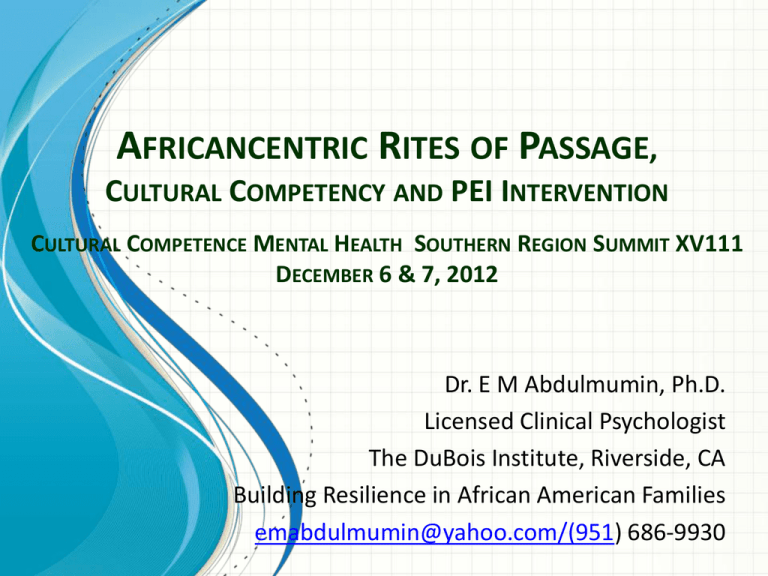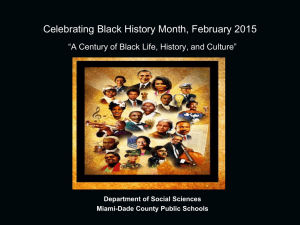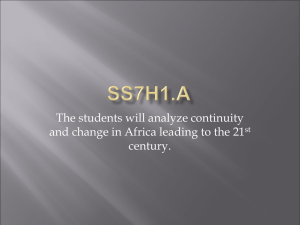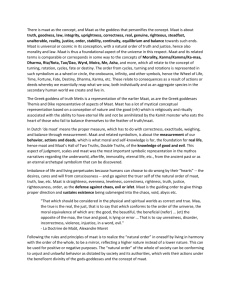Africancentric Rites of Passage, Cultural Competency and PEI
advertisement

AFRICANCENTRIC RITES OF PASSAGE, CULTURAL COMPETENCY AND PEI INTERVENTION CULTURAL COMPETENCE MENTAL HEALTH SOUTHERN REGION SUMMIT XV111 DECEMBER 6 & 7, 2012 Dr. E M Abdulmumin, Ph.D. Licensed Clinical Psychologist The DuBois Institute, Riverside, CA Building Resilience in African American Families emabdulmumin@yahoo.com/(951) 686-9930 Hipple describes the general process of African coming-of-age rituals. The first process involves a removal of individuals from their community. Then, a period of transition occurs, in which individuals learn the skills and tasks for their future community roles. Last, individuals are brought back to the community marked by a celebration. At this point, individuals are considered to have transitioned from youths to adults and actively participate in appropriate ways recognized by the community. Thus, this is a point where individuals transform their lives, and may also be marked by individuals being given a new name due to their status, and presented to the community as a different person (Hipple, 2008). Afrocentric social workers their view, the African ethos, as transmuted into African American culture, has been and is central to African Americans' ability to survive racist oppression. . In Afrocentric practice, treatment — conceived of as healing — takes place within and through positive, rewarding connections with African and African American culture and with other people of African descent. “ African Worldview Afrocentrism is predicated on traditional African philosophy that predates European and Arab influences (Schiele, 1994). Two core elements are spirituality (Pinkett, 1993) and interconnectedness (Myers, 1988). . Individuals are encouraged to prize the African and African American values of equality, cooperation, reconciliation, respect, and sharing. Connectedness is nurtured through groups. Recognizing that the effects of indirect power blocks are not easily vanquished, Afrocentric practitioners intervene over a sufficient duration to permit internalization of a positive sense of self, of other African Americans, and of African and African American heritage. The aim is respect of self, family, and community. The health consequences for African American male teenagers of living in high-risk environments are devastating. Given the existence of cultural barriers to health services use, culturally proficient programs that can engage African American male youths in preventive interventions and primary care are urgently needed. African American youth and social problems Academic Failure Social/Behavioral: Conduct Disorder Features Substance Abuse, absent fathers Disparities in Health, Mental Health and Justice Systems Cradle to Prison: Malcolm the Ghetto is a prison; Angela Davis: the PIC is the new slave system 2 million in US prisons, 1 million are African Am A culturally competent system of care "acknowledges and incorporates — at all levels — the importance of culture, the assessment of cross-cultural relations, vigilance toward the dynamics that result from cultural differences, the expansion of cultural knowledge, and the adaptation of services to meet culturally-unique needs" (Cross et al., 1989, p. 17). Basic cultural competence occurs when organizations and practitioners respect difference; engage in ongoing cultural selfassessment; expand their cultural knowledge and skills; and adapt services to fit the community's culture, situation, and perceived needs. With cultural proficiency, the group's culture is esteemed and new approaches are developed on the basis of deep cultural knowledge. (Harvey, ) • Cultural competence in mental health • Cultural competence in diverse settings • Cultural competence in an Africancentric paradigm • Cultural competence in an Africancentric Evidence Based Rites of Passage Program MAAT CENTER PROGRAM Ma'at, an ancient Egyptian word, means an ethical way of life (Karenga, 1990). The goal of the MAAT Program is empowerment of black male adolescents through a ninemonth rites of passage program.. Dr. Harvey’s Model: • Cultural Competence Orientation • Empowerment • Afrocentric Social Work Perspective • African World View Following the first weekly class and subsequent weekly meetings, students present their names ritually to the whole group, and provide the origin of their African names and its meanings. Beyond this Naming Ritual, other rituals are employed such as: (a) African dress of the teachers, (b) African names of the teacher, (e) the Opening and Physical Exercise ritual, (f) demonstrating African Leadership Rituals, and (g) the Africentric Closing 8 Week Curriculum Week Topic Week 1 Orientation Week 2 Introduction to Major Principles (Nguzo Saba, RIPSO) Week 3 Nguzo Saba, Virtues of Maat Week 4 RIPSO Week 5 Creed Week 6 Ancient African Civilization Week 7 Black Contributions to American Society Week 8 Nutrition and Food One module each week • Day one Introduction to topic • Day two speaker • Day three create a product via arts, crafts, role play, field trip, etc. Daily Schedule • Snack • Home if arrive early • Research of African American for presentation in Libation Circle • Libation Circle • Recitation of Nzugo Saba, Virtue of Maat, and Class Creed • Make take a break • Lecture and discussion or speaker, Product or fieldtrip • Break • Closing Circle • Dinner meal Nguzo Saba 10 Virtues of MAAT 1. 2. 3. 4. Control of thoughts. Control of actions. Devotion of purpose. Have faith in the ability of your teacher to teach you the truth. 5. Have faith in yourself to assimilate the truth. 6. Have faith in themselves to wield the truth. 7. Be free from resentment under the experience of persecution. 8. Be free from resentment under the experience of wrong. 9. Cultivate the ability to distinguish between right and wrong. 10. Cultivate the ability to distinguish between the real and the unreal. RIPSO Principles 7 Rs: Responsibility, Reciprocity, Respect, Restraint, Reason, Reconciliation, Realness 3 Is: Interconnectedness, Interdependence, Inclusivity, 3 Ps: Participation, Patience, Perseverance 3 Ss: Sharing, Sacrifice, Spirituality Others: Cooperation, Discipline, Unconditional Love The DuBois Institutes Class Creed We believe. We are the young men of the Rites of Passage Program. We are college bound. We are exceptional-not because we say it, but because we work hard at it. We will not falter in the face of any obstacle placed before us. We are dedicated, committed and focused. We never succumb to mediocrity, uncertainty or fear. We never fail because we never give up. We make no excuses. We choose to live honestly, nonviolently and honorably. We respect ourselves and, in doing so, respect all people. We have a future for which we are accountable. We have a responsibility to our families, community and world. We are our brothers' keepers. We believe in ourselves. We believe in each other. We believe in the Rites of Passage Program. WE BELIEVE. Conceptual Framework • • • Black Feminist Theory Black Family Theory Afrocentric Theory Afterschool format The results of this study indicated a positive impact of the Rites of Passage program on Black adolescent ethnic identity, attitudes towards school, behavior in the classroom and attitudes towards substance use. Specifically, there was positive, statistically significant data on the outcome of the measures for the intervention group in the domains of attitudes towards substance abuse and behavior in the classroom. When anyone reflects on ancient Egypt today, the Great Pyramid of Cheops and its staggering dimensions invariably are brought to mind: It stands 481 ft. high and contains 2 million blocks of yellowish limestone. Each block weights 2.5 tons, was quarried miles away, floated on barges, and dragged from the shores of the Nile to its present site. MAAT Truth and Justice, a moral standard between right and wrong Understanding Maat • The role of Pharoah was to maintain Maat • As a diety, Maat was personified as a goddess • No wrong to his fellow men and helped those more unfortunate, the deceased is declared maa kheru, “true of voice” Great Pyramid of Khufu • Near-perfect alignment to the points of the compass. • A ground area of 13.1 acres. It is composed of 2.3 million limestone blocks averaging 2.5 tons each. • Advanced knowledge of astronomy. The pyramid’s shadow disappears completely at the spring equinox. • The ancient Egyptians understood physics 1500 years before the ancient Greeks – The distance from the earth to the sun when its height in inches was multiplied by 109 ; 109 being the proportion of height to width of the pyramid. Sciences, Math, Astrology Maafa (1619 - ) The word Maafa is derived from the Swahili term for disaster, terrible occurrence or great tragedy. The Maafa refers to the 500 years of suffering of African and the African diaspora, through slavery, imperialism, colonialism, invasion, oppression, dehumanization and exploitation. The term also refers to the social and legal policies that were used to invalidate or take credit for the contributions of African peoples to humanity as a whole, and the after effect of this persecution, as seen in modern times. Sankofa can mean either the word in the Akan language of Ghana that translates in English to "go back and get it" (san - to return; ko - to go; fa - to look, to seek and take) or the Asante Adinkra symbols of a bird with its head turned backwards taking an egg off its back, or of a stylised heart shape. It is often associated with the proverb, “Se wo were fi na wosankofa a yenkyi," which translates "It is not wrong to go back for that which you have forgotten. Or the saying “Give me the Old Time Religion” Exercise and Discussion on Evidenced Based Interventions and do they increase or decrease the implementation of cultural cultural competency, delivery of services or treatment, in an Africancentric Rites of Passage Program. Break into groups and report back 3 of each and rationale










